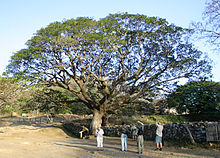Albizia saman
| Albizia saman | |
|---|---|
 |
|
| In Guanacaste, Costa Rica. | |
| Scientific classification | |
| Kingdom: | Plantae |
| (unranked): | Angiosperms |
| (unranked): | Eudicots |
| (unranked): | Rosids |
| Order: | Fabales |
| Family: | Fabaceae |
| Genus: | Albizia |
| Species: | A. saman |
| Binomial name | |
|
Albizia saman F.Muell. |
|
| Synonyms | |
|
List
|
|
Albizia saman (sometimes treated under the obsolete name Samanea saman) is a species of flowering tree in the pea family, Fabaceae, that is native to the Neotropics. Its range extends from Mexico south to Peru and Brazil, but it has been widely introduced to South and Southeast Asia, as well as the Pacific Islands, including Hawaii. Common names include saman, rain tree and monkeypod (see also below). It is often placed in the genus Samanea, which by yet other authors is subsumed in Albizia entirely.
Saman is a wide-canopied tree with a large symmetrical crown. It usually reaches a height of 25 m (82 ft) and a diameter of 40 m. The leaves fold in rainy weather and in the evening, hence the name "rain tree" and "five o'clock tree" (Pukul Lima) in Malay. Several lineages of this tree are available, e.g., with reddish pink and creamish golden colored flowers.
During his 1799–1804 travels in the Americas, Alexander von Humboldt encountered a giant saman tree near Maracay, Venezuela. He measured the circumference of the parasol-shaped crown at 576 ft (about 180.8 m), its diameter was around 190 ft (about 59.6 m), on a trunk at 9 ft (about 2.8 m) in diameter and reaching just 60 ft (nearly 19 m) in height. Humboldt mentioned the tree was reported to have changed little since the Spanish colonization of Venezuela; he estimated it to be as old as the famous Canary Islands dragon tree (Dracaena draco) of Icod de los Vinos on Tenerife.
...
Wikipedia

